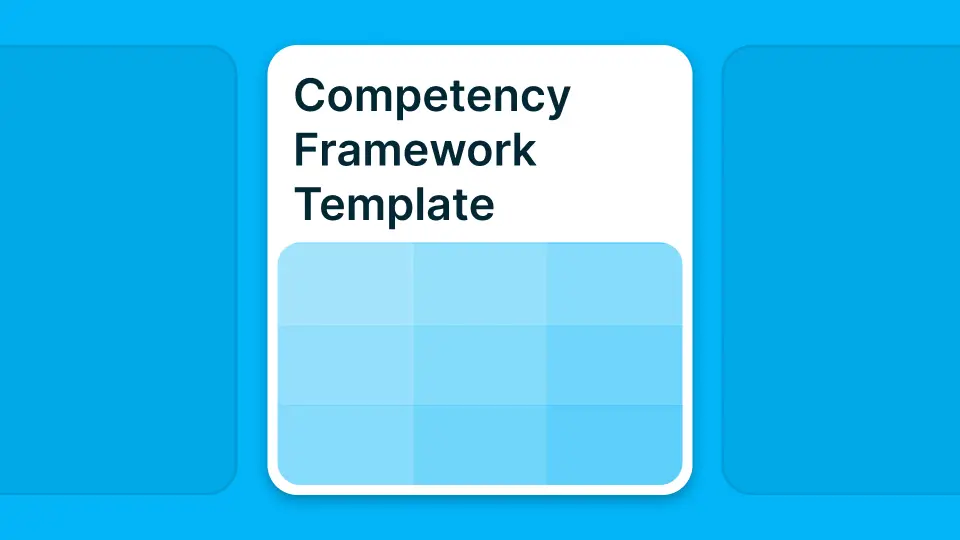A single leadership departure can cost your company millions in lost productivity, stalled projects, and team morale—yet only 14% of organizations report having a strong succession pipeline ready. When a critical role sits empty for months, the ripple effects hit revenue, customer satisfaction, and employee confidence. If you've ever scrambled to fill a key position at the last minute, you know the pain.
This guide delivers plug-and-play succession planning templates—Excel and Google Sheets assets built for quarterly or annual talent reviews. You'll get concrete workflows, governance frameworks for global teams, and hands-on examples spanning Engineering to Plant Operations. These tools help you identify critical roles, map readiness levels, and track development actions—all without drowning in theory or consultant jargon.
- Copy-ready succession planning templates for role mapping, readiness tracking, and development plans
- Step-by-step workflows from role identification through calibration and communication
- Governance insights covering diversity checks, bias avoidance, and GDPR compliance
- Real-world examples across Engineering Manager, Sales Leader, and Plant Supervisor roles
Let's break down exactly how to build a future-proof succession plan that actually gets used—starting with the foundation that makes everything else possible.
1. Mapping Critical Roles: Your Foundation for Succession Planning Templates
You can't build a real succession pipeline unless you first pinpoint which roles truly drive business outcomes—and which gaps would hurt most. This step sets the stage for every effective succession planning template that follows.
According to Deloitte's Global Human Capital Trends research, 86% of leaders say identifying critical positions is the most important step in talent planning. Yet only 43% do it systematically. Most organizations rely on informal discussions or gut feel, creating blind spots that surface only when someone resigns.
Companies that track critical roles systematically reduce leadership gaps by 50%, cutting replacement time and minimizing disruption. A global manufacturing company with high turnover in site supervisors used a Critical Roles Inventory Sheet to prioritize roles by business impact and vacancy risk. They cut replacement time from 4 months to under 6 weeks by knowing exactly where to focus development efforts.
- List all company roles and flag those with high business impact or single-point-of-failure risk
- Score each role on Vacancy Risk (how likely you'll lose the person) and Bench Strength (how many ready replacements exist)
- Combine manager input with hard data like tenure, skill scarcity, and turnover rates to avoid blind spots
- Review your inventory quarterly to keep pace with organizational changes and market shifts
- Link your critical roles inventory directly to current org charts and skill frameworks for consistency
A simple Critical Roles Inventory template tracks the essentials across your organization:
| Role | Business Impact | Vacancy Risk | Bench Strength |
|---|---|---|---|
| Engineering Manager | High | Medium | Low |
| Sales Leader | Very High | High | Medium |
| Plant Supervisor | Medium | High | Low |
| Product Owner | High | Medium | Medium |
Leverage HRIS tools or Google Sheets add-ons for live updates when organizational structures change. Color-code cells to highlight red-flag combinations like high impact with low bench strength—these are your succession planning priorities.
Once your critical roles are mapped out, the next challenge is charting who can step into them—and how soon they'd actually be ready to perform.
2. Building Your Successor Pipeline Matrix: Templates that Clarify Readiness
A clear successor pipeline matrix shows not just who could fill key roles—but how soon they'd be ready to take them on. This removes guesswork from talent reviews and gives leadership teams confidence in internal mobility.
Gartner research finds that organizations with structured successor matrices promote internally at twice the rate of their peers. When you track readiness systematically, you create transparent pathways that employees can see and work toward—boosting engagement and retention simultaneously.
Internal hires ramp up 33% faster than external hires when readiness is tracked systematically, according to Gartner Talent Research. They already know your culture, systems, and stakeholders. A SaaS company built a Successor Pipeline Matrix using Google Sheets—tracking "Ready Now," "Ready in 6–12 months," and "Ready in 12–24 months" for every critical role. During a surprise VP resignation, they filled the gap internally within three weeks instead of launching a costly external search.
- For each critical role, list potential successors with their current role and title
- Define clear readiness stages: Ready Now, Ready in 6–12 months, Ready in 12–24 months
- Document specific development needs for each candidate to reach the next readiness level
- Review readiness status at least twice yearly during talent reviews—more often for high-priority roles
- Visualize gaps with color coding or conditional formatting to spot pipeline weaknesses instantly
Your Successor Pipeline Matrix connects role criticality to specific people and timelines:
| Critical Role | Successor Name | Current Role | Readiness | Development Need |
|---|---|---|---|---|
| Sales Leader | Dana Li | Account Director | Ready Now | None—ready for promotion |
| Plant Supervisor | Alex Kim | Shift Lead | 6–12 months | Safety certification + budget training |
| Engineering Manager | Priya Shah | Senior Engineer | 12–24 months | Cross-team project lead experience |
| Product Owner | Marco Ruiz | Product Analyst | 6–12 months | Stakeholder management + roadmap skills |
Automate reminders for periodic readiness reassessments using Google Sheets notifications or calendar integrations. Set quarterly check-ins where managers update development progress and adjust timelines based on performance and business changes.
But knowing who's next isn't enough—you need clear criteria and objective assessment tools to identify true potential fairly and consistently across your organization.
3. Assessing Performance & Potential: The Power of the 9-Box Grid
The classic nine-box grid takes subjectivity out of talent decisions by plotting performance versus potential on a simple matrix. This makes it ideal for fair succession decisions that withstand scrutiny from leadership, employees, and works councils alike.
About 70% of Fortune 500 firms use some form of the nine-box matrix in their talent review processes, according to CEB research. The tool has staying power because it forces conversations about who truly has both track record and runway—not just one or the other.
Teams using the nine-box grid reduce promotion bias incidents by up to 28%, according to SHRM research. When managers must justify ratings on two dimensions with evidence, personal favoritism becomes harder to hide. A European fintech scaled its annual review process using a digital nine-box template—leading to more diverse promotions and higher trust in HR processes across the organization.
- Rate employees on recent performance using objective KPIs—Below, Meets, or Exceeds expectations
- Assess potential based on learning agility and leadership behaviors, not just tenure or current role mastery
- Use color-coded grids to flag top-right quadrant (High Potential / High Performance) as immediate succession candidates
- Hold calibration sessions with multiple managers to reduce individual bias and align standards
- Update your grid regularly based on new project results, feedback cycles, and changing business needs
A practical nine-box succession planning template links names to positions on the grid:
| Name | Current Role | Performance | Potential | Box Position | Action |
|---|---|---|---|---|---|
| Dana Li | Account Director | Exceeds | High | High/High | Promote or retain aggressively |
| Alex Kim | Shift Lead | Meets | Medium | Medium/Medium | Core contributor—develop selectively |
| Priya Shah | Senior Engineer | Meets | High | Medium/High | High-potential—invest in growth |
| Marco Ruiz | Product Analyst | Exceeds | Medium | High/Medium | Strong performer—expand scope |
Connect your nine-box output directly with Individual Development Plans (IDPs) for continuity. When someone lands in the high-potential quadrant, their IDP should reflect accelerated growth opportunities—stretch assignments, mentorship, or cross-functional exposure that prepares them for bigger roles.
Now that you've surfaced your high-potential players, what does it actually take for someone to be considered "ready" for a critical role?
4. Defining Readiness Criteria & Development Actions: From Theory To Practice
Defining readiness isn't about gut feel—it's about clear milestones tied to skills, experience, and targeted development actions tracked over time. Without concrete criteria, succession planning templates become opinion documents instead of decision-making tools.
LinkedIn's Global Talent Trends shows companies with clear readiness criteria have a 23% higher internal mobility rate. Employees can see what they need to do, managers can coach toward specific goals, and HR can measure progress objectively.
Only 34% of HR leaders use formal readiness criteria today—leaving room for error and missed opportunities, according to LinkedIn. A mid-sized tech firm developed custom readiness checklists per role—including mandatory trainings and project experience—then tracked completion via an Excel sheet linked to their learning platform. The result was faster promotions and fewer surprises when positions opened up.
- Define must-have competencies per role using your skill framework or taxonomy
- Specify required experiences like "managed a team of 10+" or "led cross-functional project over EUR 500k budget"
- Track completion via a Development Actions sheet covering mentorships, projects, and formal training
- Set regular check-ins between employee and manager to review progress and adjust plans
- Document outcomes so promotion committees have clear audit trails supporting internal moves
A Development Actions tracker connects readiness criteria to actual progress:
| Successor Name | Target Role | Competencies Met? | Key Projects Completed | Trainings Done | Readiness Status |
|---|---|---|---|---|---|
| Dana Li | Sales Leader | Yes | Closed EUR 1.2M deal, led QBR | Sales Leadership Program | Ready Now |
| Alex Kim | Plant Supervisor | No | Managed 15-person shift | In Progress—safety cert | 6–12 months |
| Priya Shah | Eng Manager | Yes | Not yet—needs cross-team lead | Leadership Foundations | 12–24 months |
| Marco Ruiz | Product Owner | Partial | Led roadmap for feature X | Agile Product Management | 6–12 months |
Tie development actions back into compensation bands so employees see tangible rewards for growth. When someone completes required projects and trainings, their readiness status should trigger eligibility for promotion and corresponding salary adjustments—making the process transparent and motivating.
Once readiness is transparent and documented, the next challenge is ensuring fairness—through robust governance practices that withstand scrutiny worldwide.
5. Governance & Fairness: Bias Checks, Data Privacy & Global Compliance
Succession planning only works if it's trusted. That means tackling bias head-on while respecting data privacy laws like GDPR—and local requirements like Works Council input in DACH countries. Without governance, even the best templates become liability risks.
McKinsey reports companies with diverse succession pipelines outperform less diverse peers by up to 36% in profitability. Fairness isn't just ethical—it's a competitive advantage that drives better decisions and broader talent pools.
About 40% of EU-based HR teams cite Works Council approval as a major hurdle in rolling out new HR processes, according to Eurofound surveys. A German automotive supplier built Works Council review checkpoints into their succession planning template workflow—speeding up approvals while meeting strict data handling rules under GDPR. The early collaboration prevented delays and built trust with employee representatives.
- Add diversity and fairness columns in every template review cycle—track gender, ethnicity, age, and other dimensions
- Apply anonymized scoring where possible during calibration sessions to reduce halo effects and favoritism
- Store sensitive data only in GDPR-compliant platforms with encryption and role-based access controls
- Build Works Council consultation steps into DACH-region workflows early—don't treat it as an afterthought
- Audit your process annually against changing legal standards globally and locally, adjusting templates as needed
Use DEI dashboards alongside your main succession planning spreadsheets for ongoing monitoring. Track representation at each readiness level and flag when certain groups are underrepresented in high-potential categories—then investigate root causes and adjust development access accordingly.
With governance locked down, let's see what these succession planning templates look like applied across real-world roles—from engineering management through frontline supervision.
6. Real-Life Examples: Applying Succession Planning Templates Across Functions
Templates aren't one-size-fits-all—they shine brightest when tailored for specific jobs like Engineering Manager, Sales Leader, or Plant Supervisor. Different roles demand different readiness criteria and development paths.
Engineering teams lose an average of EUR 240,000 per vacant manager position due to delays in product delivery, according to Glassdoor Economic Research. In sales organizations with structured succession plans, quota attainment rises by up to 18%, CSO Insights reports. The business case for role-specific succession planning is clear and measurable.
Here's how succession planning templates adapt across three common critical roles:
| Role | Key Template Used | Readiness Milestones | Development Actions |
|---|---|---|---|
| Engineering Manager | Critical Roles Inventory + Dev Tracker | Led cross-functional team; completed mentorship program; delivered product launch | Pair with current manager for 6 months; lead sprint planning; attend leadership training |
| Sales Leader | Successor Pipeline Matrix + IDP | Closed >EUR 1M deals; presented at QBR; built account plan for top 3 clients | Shadow VP on strategic deals; run team pipeline reviews; complete sales leadership course |
| Plant Supervisor | Attrition Risk Heatmap + Skills Map | Managed >25 FTE shift; safety certification completed; reduced incidents by 20% | Rotate through maintenance and quality; lead safety audit; budget management training |
| Product Owner | 9-Box Grid + Career Framework | Owned feature roadmap; stakeholder alignment on 3+ initiatives; agile certification | Lead discovery with customers; present to exec team; mentor junior PM |
- Adjust criteria and milestones based on business unit realities—what works in software doesn't always fit manufacturing
- Collaborate with line managers on skills mapping to capture role-specific nuances
- Use past promotion stories as benchmarks for realistic timelines and development paths
- Include both technical competencies and soft skills like conflict resolution or strategic thinking per function
- Regularly recalibrate based on business results—if promoted successors struggle, revisit your readiness criteria
An engineering manager needs deep technical credibility plus people leadership—track both dimensions in your succession planning template. A sales leader requires proven revenue results plus coaching ability—document deals closed and team development wins. A plant supervisor must balance safety compliance with operational efficiency—measure incident rates alongside productivity metrics.
For robust career progression and fair promotions, you need seamless handoffs between these succession planning templates and your compensation and promotion committee processes.
7. Connecting Succession Plans To Compensation Bands & Promotion Committees
Succession plans should feed directly into compensation reviews and promotion committee deliberations—to reward growth fairly and transparently across the org chart. When these systems operate separately, employees see promotions as political rather than merit-based.
Mercer reports that organizations aligning promotion decisions with structured readiness data see retention rise by over 15%. Employees trust the process more when they see clear connections between development progress, readiness status, and actual promotions.
Only about half of large enterprises currently link their succession plans explicitly to pay bands or promotion policies—a big missed opportunity, according to Mercer Global Talent Trends. A US-based biotech firm embedded readiness outputs from its Excel templates into annual merit review packets—for both HRBPs and committee chairs. This improved transparency around internal moves and salary adjustments after promotions were made from within the bench pipeline rather than sourced externally.
- Export candidate status and readiness levels directly into compensation review spreadsheets each cycle
- Make IDP progress visible during salary and promotion discussions so committees see development investments
- Set guidelines so only fully "ready" candidates are eligible for fast-track raises or promotions—no shortcuts
- Give feedback loops so employees understand growth paths AND pay implications at each readiness stage
- Train promotion committees on reading and interpreting succession planning template data fairly and consistently
A Promotion Committee Dashboard links succession data to compensation decisions:
| Employee Name | Current Role | Ready For Promotion? | Current Salary Band | Target Band | Last Committee Review |
|---|---|---|---|---|---|
| Dana Li | Account Director | Yes | E3 | E4 | Q1 2024 |
| Alex Kim | Shift Lead | Not yet | S2 | S3 | Q3 2023 |
| Priya Shah | Senior Engineer | In progress | E2 | E3 | Q2 2024 |
| Marco Ruiz | Product Analyst | In progress | P2 | P3 | Q4 2023 |
Schedule joint meetings between HRBPs, talent leads, and compensation specialists before finalizing offers or promotions based on bench outputs. Audit annually to ensure readiness criteria truly predict promotion success—if promoted successors struggle or leave quickly, your criteria need refinement.
With your full toolkit—from mapping through governance to compensation integration—you're ready to put these succession planning templates into action year-round.
Conclusion: Make Your Succession Planning Stick—From Template To Reality
Effective succession planning starts with structured role mapping—and lives or dies by transparent successor pipelines tied tightly to objective assessment tools like the nine-box grid. Without this foundation, you're guessing instead of planning.
The best plans depend not just on documentation but also proactive governance—including diversity checks and airtight data handling across regions like DACH and the EU. When employees and works councils trust your process, adoption follows naturally.
Linking development milestones directly into compensation and promotion cycles creates sustainable motivation—for both employees and leadership teams—while reducing costly external hiring needs. Your succession planning template becomes a strategic asset instead of an HR filing requirement.
Download ready-to-use Excel or Google Sheets templates covering inventory mapping through development tracking. Run your first quarterly calibration using real performance and potential data—not gut feel alone. Integrate regular diversity and bias reviews plus GDPR compliance checks into every stage. Collaborate cross-functionally—from plant operations through sales—to tailor milestones per job family.
As AI-driven skills mapping matures and regulatory demands rise, the smartest HR leaders will keep refining their templates and workflows together—ensuring no leadership seat ever sits empty again.
Frequently Asked Questions (FAQ)
What is a succession planning template and why does every organization need one?
A succession planning template is a structured spreadsheet or document that helps HR teams track key positions, identify potential successors, map their readiness levels, and manage related development actions—all in one place. These tools make it much easier to run fair talent reviews regularly while reducing leadership gaps when someone leaves unexpectedly. Without a template, succession planning stays informal and inconsistent—leading to scrambling when critical roles open up.
How often should we update our succession planning spreadsheets or matrices?
Best practice is updating your succession planning templates at least once per quarter—or immediately following any major organizational changes like restructures, acquisitions, or leadership departures. If you operate in fast-moving industries like tech or retail with high turnover, consider monthly check-ins as well. The key is keeping readiness status current so you can act quickly when opportunities or gaps arise.
Who should own the maintenance of our company's succession plan documents?
While ultimate accountability sits with senior HR leaders or People Partners, maintaining day-to-day updates often works best when shared between line managers (who know their people) and central HR teams overseeing calibration and governance. Always clarify ownership at rollout—ambiguity leads to stale data and missed opportunities. Some organizations assign HRBP responsibility by business unit for better responsiveness.
What are some best-in-class criteria for assessing readiness within our successor pipeline matrix?
Strong readiness criteria combine technical competencies from your skill framework, proven experience in similar projects or roles, relevant training completions, plus clear behavioral signals like adaptability and learning agility. Don't rely solely on tenure or subjective recommendations. Define must-have milestones like "led cross-functional team of 10+" or "closed deals over EUR 500k" so readiness becomes objective and defensible. Update criteria when promoted successors struggle—that feedback loop improves future assessments.
How can we ensure fairness and avoid bias in our succession planning process?
Build diversity and fairness checks right into every review cycle. Use anonymized ratings where possible during calibration sessions to reduce halo effects. Hold multi-manager calibration sessions to align standards and challenge individual biases. Audit outcomes against DEI goals and flag when certain groups are underrepresented at higher readiness levels. Always store sensitive data securely according to laws like GDPR, and in DACH regions consult works councils early in the process. Regular audits keep bias traps at bay and maintain trust across your organization.












